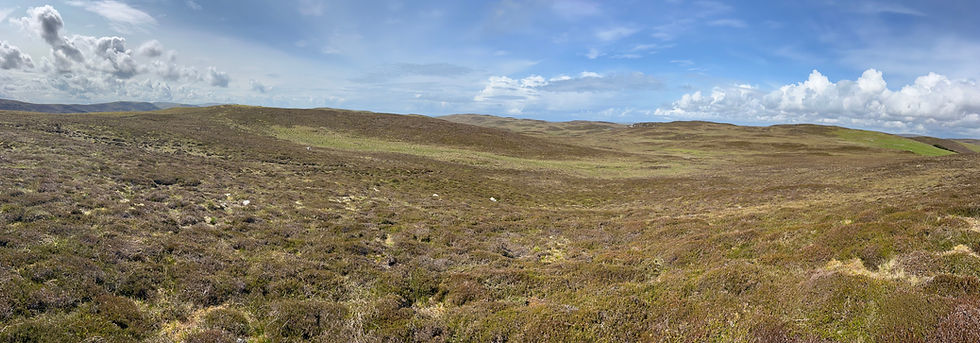Site in Focus - Burn of Roerwater and a Word about Pictish Multicellular Sites
- Stephen Jennings

- Mar 31, 2022
- 3 min read

The move away from monumental architecture and into more ephemeral structures in the LIA is not fully understood though it is clear what we consider the markers of social status had changed. Elaborately decorated and portable personal objects appear to signal stature and affiliation (Foster 2001: 61; Sharples 2003: 157), the Pictish symbol stones found throughout most of Scotland resulting perhaps from a growth in shared identity (Noble et al. 2013: 1138). However, additional societal and environmental pressures, often deemed too deterministic (Harding 2004: 296), must surely have played a defining role.
Following the withdrawal of Rome from mainland Scotland, an extended period of internal conflict followed which can be demonstrated in the archaeological record such as a sudden increase of weaponry in the 5th century at Upper Scalloway (Sharples 1998; Sharples 2003: 156) and Mine Howe in Orkney (Sharples 2003: 157; Heald and Jackson 2001). The Dal Riata and the Picts long competed for control throughout Scotland (Foster 2001: 101-3) including the Northern Isles where the Annals of Ulster record Dal Riata invasions of Orkney in 580 or 581 (Mac Airt and Mac Niocaill 1983). Complicating matters, the possible widespread disaster of the ‘dust veil event’ of 536-7 may have led to demographic collapse and large-scale movement of people (Gräslund and Price 2012; MacKie 2010: 111). Indeed, a variety of Irish annals record famine in 536 and 539. Adding to the misery, the Annales Cumbriæ records plague in Wales in 537 and 547 (Ingram 1912), the Annals of Ulster in 545 and 556 with a spread of leprosy in 554 (Mac Airt and Mac Niocaill 1983). It is doubtless such events would have touched the shores of the Northern Isles, the Justinian plague lasting until the end of the 6th century and killing as much as 30% of the European population (Raoult et al. 2013).
Perhaps for these reasons the move to small, multicellular architecture was a necessity requiring far less material and labour resources to build and maintain (Sharples 2003: 159).

Burn of Roerwater tape and offset drawing.

Burn of Roerwater drone image. Photograph © Vivian Clark.
References
Foster, S. (2001) Picts, Gaels and Scots. London: B. T. Batsford Ltd.
Gräslund, B. and Price, N. (2012) ‘Twilight of the gods? The ‘dust veil event’ of AD 536 in critical perspective’. Antiquity, 86 (332), 428-443.
Harding, D.W. (2004) The Iron Age in Northern Britain: Britons and Romans, Natives and Settlers. London: Routledge.
Heald, A. and Jackson, A. (2001) ‘Towards a new understanding of Iron Age Caithness’. Proceedings of the Society of Antiquaries of Scotland, 131, 129-147.
Ingram, J. (1912) The Anglo-Saxon Chronicle. London: Everyman Press. Available from <https://sourcebooks.fordham.edu/source/annalescambriae.asp> [29 August 2021].
Mac Airt, S. and Mac Niocaill, G. (1983) The Annals of Ulster (to A.D. 1131). Dublin: Dublin Institute for Advanced Studies. Available from <https://celt.ucc.ie//published/T100001A/> [29 August 2021].
MacKie, E (2010) ‘The Broch Cultures of Atlantic Scotland. Part 2. The Middle Iron Age: High Noon and Decline c.200 BC–AD 550’. Oxford Journal of Archaeology, 29 (1), 89–117.
Noble, G., Gondek, M., Campbell, E. and Cook, M. (2013) ‘Between prehistory and history: the archaeological detection of social change among the Picts’. Antiquity, 87, 1136-1150.
Raoult, D., Mouffok, N., Bitam, I., Piarroux, R. and Drancourt, M. (2013) ‘Plague: History and contemporary analysis’. Journal of Infection, 66 (1), 18-26.
Sharples, N. (1998) Scalloway: A Broch, Late Iron Age Settlement and Medieval Cemetery in Shetland. Oxford: Oxbow Books.
Sharples, N. (2003) ‘From monuments to artefacts: changing social relationships in the later Iron Age’. In Sea Change: Orkney and Northern Europe in the later Iron Age AD 300-800. Ed. by Downes, J. and Ritchie, A. Balgavies: The Pinkfoot Press.







Comments